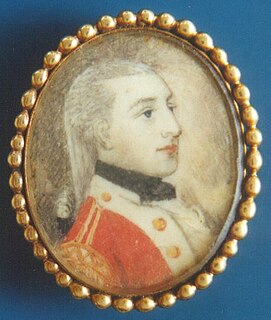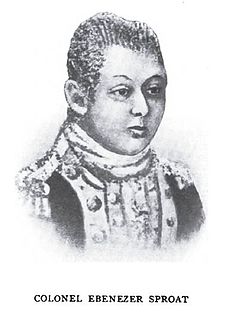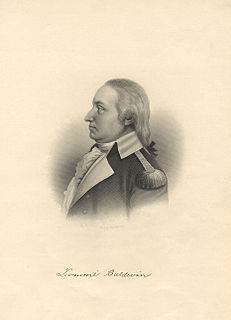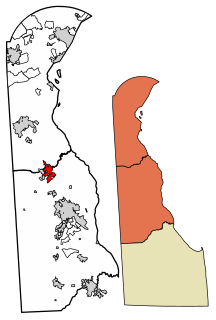
John Cleves Symmes was a delegate to the Continental Congress from New Jersey, and later a pioneer in the Northwest Territory. He was also the father-in-law of President William Henry Harrison.

Edward Hand was an Irish-born soldier, physician, and politician who served in the Continental Army during the American Revolutionary War, rising to the rank of general, and later was a member of several Pennsylvania governmental bodies.
Jean-Bernard Gauthier de Murnan was a French officer for the Continental Army and a French General during the French Revolution.
Colonel William Butler was a Pennsylvania officer during the American Revolutionary War, known for his leadership in the Battle of Monmouth, the burning of the Indian villages at Unadilla and Oquaga, and in the Sullivan-Clinton Expedition.
Thomas "Tommy" Rodney was an American lawyer and politician from Jones Neck in St. Jones Hundred, Kent County, Delaware and Natchez, Mississippi. He was a Continental Congressman from Delaware, and a member of the Democratic-Republican Party who served in the Delaware General Assembly, as Justice of the Delaware Supreme Court, and as federal judge for the Mississippi Territory. He was the younger brother of Caesar Rodney, Revolutionary President of Delaware.

James Tilton was an American physician and soldier from Dover, Delaware. He was a delegate for Delaware in the Continental Congress of 1783 and 1784, and served as Surgeon General of the United States Army during the War of 1812.

Samuel Elbert was an American merchant, soldier, and politician from Savannah, Georgia.

Thomas Hartley was an American lawyer, soldier, and politician from York, Pennsylvania.
James Reed was a military officer in the French and Indian War and the American Revolution, rising to the rank of brigadier general in the latter conflict.

The Connecticut Line was a formation within the Continental Army. The term "Connecticut Line" referred to the quota of numbered infantry regiments assigned to Connecticut at various times by the Continental Congress, the size of its allocation determined by the size of its population relative to that of other states. These, together with similarly apportioned contingents from the other twelve states, formed the Continental Line. The concept was particularly important in relation to the promotion of commissioned officers. Officers of the Continental Army below the rank of brigadier general were ordinarily ineligible for promotion except in the line of their own state.
Robert Henry Kirkwood was a soldier who fought in the American Revolutionary War and the Battle of the Wabash.
Samuel Hammond was a lieutenant colonel during the American Revolutionary War, governor and leader in the Louisiana and Missouri Territories, and United States Representative from Georgia in the 8th United States Congress.

Otho Holland Williams was a Continental Army officer from Maryland in the American Revolutionary War. He participated in many battles throughout the war in the New York, New Jersey and Southern theaters, eventually ending his career as a Brigadier General.

Christopher Greene was an American legislator and soldier. He is best known for leading the spirited defense of Fort Mercer in the 1777 Battle of Red Bank, and for leading the African American 1st Rhode Island Regiment during the American Revolutionary War, most notably with distinction in the 1778 Battle of Rhode Island. He was killed in May 1781 at the Battle of Pine's Bridge by Loyalists, possibly because he was known to lead African American troops.

Ebenezer Sproat, surname also spelled Sprout, was an officer of the Continental Army during the American Revolutionary War, a pioneer to the Ohio Country, and one of the founders of Marietta, Ohio, the first permanent American settlement in the Northwest Territory. He served throughout the entire American war of independence, from April 1775 through November 1783, achieving the rank of colonel. After the war, he was a pioneer and surveyor in the Northwest Territory, and became a leader of the militia at Marietta during the Northwest Indian War. He was the first sheriff in the Northwest Territory and Ohio, serving fourteen years as sheriff of Washington County, the oldest county in Ohio.

Lachlan McIntosh was a Scottish American military and political leader during the American Revolution and the early United States. In a 1777 duel, he fatally shot Button Gwinnett, a signer of the Declaration of Independence.
Daniel Hitchcock was born in Massachusetts and graduated from Yale University. He moved to Providence, Rhode Island where he became an attorney and was suspected by the authorities of involvement in the Gaspee Affair. At the start of the American Revolutionary War he formed Hitchcock's Regiment of infantry in the Rhode Island Army of Observation. He was first appointed lieutenant colonel in command of the regiment when it marched to serve in the Siege of Boston in 1775. His regiment was renamed the 11th Continental Regiment during 1776. That year, he led his troops at Long Island, Harlem Heights, and White Plains.

The 26th Continental Regiment was an infantry unit of the Massachusetts Line during the American Revolutionary War. Gerrish's Regiment was raised in the early days of the war, and the regiment underwent name changes as the Continental Army was reorganized in 1776 and 1777. From 1777 onward, the unit was known as the 9th Massachusetts Regiment.

Francis Tennille, was a Lieutenant Colonel during the American Revolutionary War who fought for the American Continental Army.















